Design and Experimental Study of Ball-Head Cone-Tail Injection Mixer Based on Computational Fluid Dynamics
Abstract
:1. Introduction
2. Structural Design and Numerical Simulation of the Mixer
2.1. Structural Design of the Mixer
2.2. Numerical Simulation of the Mixer
2.2.1. CFD Mathematical Modeling
2.2.2. Boundary Conditions and Simulation Parameters
2.2.3. Meshing
3. Simulation Tests and Analysis of Results
3.1. Methodology and Indicators
3.2. Simulation Results and Analysis
3.2.1. Influence of the Head Structure Shape on the Mixing Effect
3.2.2. Influence of the Height of the Deflector on the Mixing Effect
3.2.3. Influence of the Angle of the Deflector on the Mixing Effect
3.2.4. Influence of the Structure and Number of Deflectors on the Mixing Effect
3.2.5. Effect of Changes in Mixing Ratio on the Mixing Effect
4. Mixing Uniformity Test
4.1. Qualitative Analysis of Mixing Uniformity of Ball-Head Cone-Tail Mixer
4.1.1. Test Conditions
4.1.2. Area Calibration of the Mixer Observation Tube
4.1.3. RMSE Analysis
4.2. Quantitative Analysis of Mixing Uniformity of Ball-Head Cone-Tail Mixer
4.2.1. Test Methods and Calibration
- (1)
- Sampling from the outlet of the mixer for 2 s at 30 s intervals to obtain 5 samples of the mixture at different times.
- (2)
- Sampling ten points at different spatial locations between the outlet end of the mixer and the nozzle and each for 2 s.
4.2.2. Temporal Distribution Uniformity Test
4.2.3. Spatial Uniformity Test
5. Conclusions
Author Contributions
Funding
Institutional Review Board Statement
Acknowledgments
Conflicts of Interest
References
- He, X. Research progress and developmental recommendations on precision spraying technology and equipment in China. Smart Agric. 2020, 2, 133–146. [Google Scholar]
- Tudi, M.; Daniel, R.H.; Wang, L.; Lyu, J.; Sadler, R.; Connell, D.; Chu, C.; Phung, D.T. Agriculture Development, Pesticide Application and Its Impact on the Environment. Int. J. Environ. Res. Public Health 2021, 18, 1112. [Google Scholar] [CrossRef] [PubMed]
- Ki-Hyun, K.; Ehsanul, K.; Shamin, A.J. Exposure to pesticides and the associated human health effects. Sci. Total Environ. 2017, 575, 525–535. [Google Scholar]
- Sun, M.; Gu, S.; Kong, D.; Hui, X.; Sun, Z. The existing problems of pesticide use and the countermeasures. J. North. Agric. 2004, 50, 141–143. [Google Scholar]
- He, X.; Yan, J.; Wang, Y. T-shaped micromixer with periodic baffles. Opt. Precis. Eng. 2015, 23, 2877–2886. [Google Scholar]
- He, P.; Wu, C.; Chen, C.; Wang, G.; Li, X. Performance of a new type spraying mixing apparatus. Trans. Chin. Soc. Agric. Mach. 2001, 3, 44–47. [Google Scholar]
- Yu, Y.; Wu, J.; Meng, H. Numerical simulation process aspects of the novel static circulating jet mixer. Can. J. Chem. Eng. 2011, 89, 460–468. [Google Scholar] [CrossRef]
- Fang, K.; Qiu, W.; Zhou, L. Design of jet mixer based on theoretical model and CFD assistance. J. Chin. Agric. Mech. 2023, 44, 65–70. [Google Scholar]
- Zhou, L.; Fu, X.; Xue, X.; Zhou, L.; Kong, W.; Qiu, W. Design and experiment of jet mixing apparatus based on CFD. Trans. Chin. Soc. Agric. Mach. 2013, 44, 107–112. [Google Scholar]
- Qi, H.; Liao, H.; Lan, Y. Research status and prospect of automatic pesticide mixing device. J. Agric. Sci. Technol. 2019, 21, 10–18. [Google Scholar]
- Shi, Y.; Jiang, P.; Xiang, S.; Zhai, S. Design and optimization analysis of multi-source inmixer based on CFD. Agric. Eng. Equip. 2022, 49, 6–10. [Google Scholar]
- Liu, T.; Ma, Y.; Yang, W.; Ji, W.; Wang, R.; Jiang, P. Spatial-temporal interaction learning based two-stream network for action recognition. Inf. Sci. 2022, 606, 864–876. [Google Scholar] [CrossRef]
- Eakarach, B. A review on numerical consideration for computational fluid dynamics modeling of jet mixing tanks. Korean J. Chem. Eng. 2016, 33, 3050–3068. [Google Scholar]
- Song, Y.; Lei, Z.; Lu, X.; Xu, G.; Zhu, J. Optimization of a Lobed Mixer with BP Neural Network and Genetic Algorithm. J. Therm. Sci. 2023, 32, 387–400. [Google Scholar] [CrossRef]
- Wu, Z.; Fan, D.; Zhou, Y.; Li, R.; Noack, B.R. Jet mixing optimization using machine learning control. Exp. Fluids 2018, 59, 131. [Google Scholar] [CrossRef] [Green Version]
- Li, Y.; Wu, S.; Liu, Y.; Wang, N.; Dai, P.; Yang, Q.; Lu, H. The coupled mixing action of the jet mixer and swirl mixer: An novel static micromixer. Chem. Eng. Res. Des. 2022, 177, 283–290. [Google Scholar] [CrossRef]
- Sun, D.; Liu, W.; Li, Z.; Zhan, X.; Dai, Q.; Xue, X.; Song, S. Numerical Experiment and Optimized Design of Pipeline Spraying On-Line Pesticide Mixing Apparatus Based on CFD Orthogonal Experiment. Agronomy 2022, 12, 1059. [Google Scholar] [CrossRef]
- Song, H.; Xu, Y.; Zheng, J.; Dai, X. Structural parameters optimization of swirling jet mixer based on reducing effective length. Trans. Chin. Soc. Agric. Eng. 2018, 34, 62–69. [Google Scholar]
- Song, H.; Xu, Y.; Zheng, J.; Wang, X.; Zhang, M. Structural analysis and mixing uniformity experiments of swirling jet mixer for applying fat-soluble pesticides. Editor. Off. Trans. Chin. Soc. Agric. Eng. 2016, 32, 86–92. [Google Scholar]
- Zhao, S.; Sheng, L.; He, W.; Zhu, N.; Li, Y.; Ji, D.; Guo, K. Design and optimization of a novel ellipsoidal baffle mixer with high mixing efficiency and low pressure drop. J. Chem. Technol. Biotechnol. 2022, 97, 3121–3131. [Google Scholar] [CrossRef]
- Mahmoodi, H.; Razzaghi, K.; Shahraki, F. Improving mixing performance by curved-blade static mixer. AIChE J. 2020, 66, e17034. [Google Scholar] [CrossRef]
- Xu, Y.; Wang, X.; Zheng, J.; Zhou, F. Simulation and experiment on agricultural chemical mixing process for direct injection system based on CFD. Trans. Chin. Soc. Agric. Eng. 2010, 2010, 148–152. [Google Scholar]
- Zhao, S.; Nie, Y.; Wei, Y.; Yu, P.; He, W.; Zhu, N.; Li, Y.; Ji, D.; Guo, K. Design and parametric optimization of a fan-notched baffle structure mixer for enhancement of liquid-liquid two-phase chemical process. Int. J. Chem. React. Eng. 2022, 21, 687–699. [Google Scholar] [CrossRef]
- Shi, Y.; Jiang, P.; Wang, F.; Zhou, S. Experimental Study on Mixing Uniformity of Injection On-Line Mixer of Crop Protection Equipment. Int. J. Heat Technol. 2021, 39, 1143–1152. [Google Scholar] [CrossRef]
- Lei, H.; Guan, X.; Sun, Y.; Yan, H. A novel design of in-line static mixer for permanganate/bisulfite process: Numerical simulations and pilot-scale testing. Water Environ. Res. 2022, 94, e10725. [Google Scholar] [CrossRef] [PubMed]
- Chen, J.; Xu, Y. Analysis method of pesticide on-line-mixing uniformity based on principal component analysis. J. For. Eng. 2019, 4, 121–127. [Google Scholar]
- Yi, P.; Ma, S.; Zhang, J. Application and practice of CFD numerical simulation in the teaching fluid mechanics. J. Yili Norm. Univ. (Nat. Sci. Ed.) 2022, 16, 69–76. [Google Scholar]
- Aanjaneya, K.; Agrawal, S. Optimization of twisted-tape element static mixers for industrially relevant setups. Chem. Eng. Res. Des. 2023, 191, 426–438. [Google Scholar] [CrossRef]
- Zhou, M.; Bai, D.; Zong, Y.; Zhao, L.; Thornock, J.N. Numerical investigation of turbulent reactive mixing in a novel coaxial jet static mixer. Chem. Eng. Process. Process Intensif. 2017, 122, 190–203. [Google Scholar] [CrossRef]
- Soman, S.S.; Madhuranthakam, C.M. Effects of internal geometry modifications on the dispersive and distributive mixing in static mixers. Chem. Eng. Process. Process Intensif. 2017, 122, 31–43. [Google Scholar] [CrossRef]
- Yang, J. Selection and design application of static mixer. Chem. Equip. Technol. 1999, 20, 25–29. [Google Scholar]
- El Habet, M.A.; Ahmed, S.A.; Saleh, M.A. Thermal/hydraulic characteristics of a rectangular channel with inline/staggered perforated baffles. Int. Commun. Heat Mass Transf. 2021, 128, 105591. [Google Scholar] [CrossRef]
- Zhang, K. Fluent Technology Foundation and Application Examples; Tsinghua University Press: Beijing, China, 2010. [Google Scholar]
- Heiszwolf, J.; Nyssen, O. Improving dry sorbent injection with computational fluid dynamics. NPT Procestechnol. 2016, 1, 12–13. [Google Scholar]
- Alexey, K.; Vladimir, K.; Alexey, C.; Vyacheslav, T. Modelling the effect of continuous mixer operating parameters on mixture quality. E3S Web Conf. 2020, 164, 08009. [Google Scholar]
- Zhao, X.; Xu, J. Design and implementation of ultra-micro nucleic acid protein analyzer. Chin. J. Med. Instrum. 2020, 44, 403–408. [Google Scholar]
- Wang, S.; Zhang, T.; Zhao, Q.; Lyu, C. Settling performance of new type mixer-settler. J. Northeast. Univ. (Nat. Sci.) 2014, 35, 548–550. [Google Scholar]
- Kimthet, C.; Wahyudiono; Hideki, K.; Shin-Ichro, K.; Motonobu, G. Micronization of curcumin with biodegradable polymer by supercritical anti-solvent using micro swirl mixer. Front. Chem. Sci. Eng. 2018, 12, 184–193. [Google Scholar]
- Pourahadi, A.; Farahani, A.; Hosseiny, D.S.S.; Nojavan, S.; Tashakori, C. Developing a miniaturized setup for in-tube simultaneous determination of three alkaloids using electromembrane extraction in combination with ultraviolet spectrophotometry. J. Sep. Sci. 2019, 42, 3126–3133. [Google Scholar] [CrossRef]
- Petit, J.; Ait-Mouheb, N.; Mas, G.S.; Metz, M.; Molle, B.; Bendoula, R. Potential of visible/near infrared spectroscopy coupled with chemometric methods for discriminating and estimating the thickness of clogging in drip-irrigation. Biosyst. Eng. 2021, 209, 246–255. [Google Scholar] [CrossRef]
- Zeynep, K.A.; Şule, A. An Example of the Use of Spectrophotometric Method: Determining the Carmine in Various Food Products. Procedia-Soc. Behav. Sci. 2014, 116, 4622–4625. [Google Scholar]

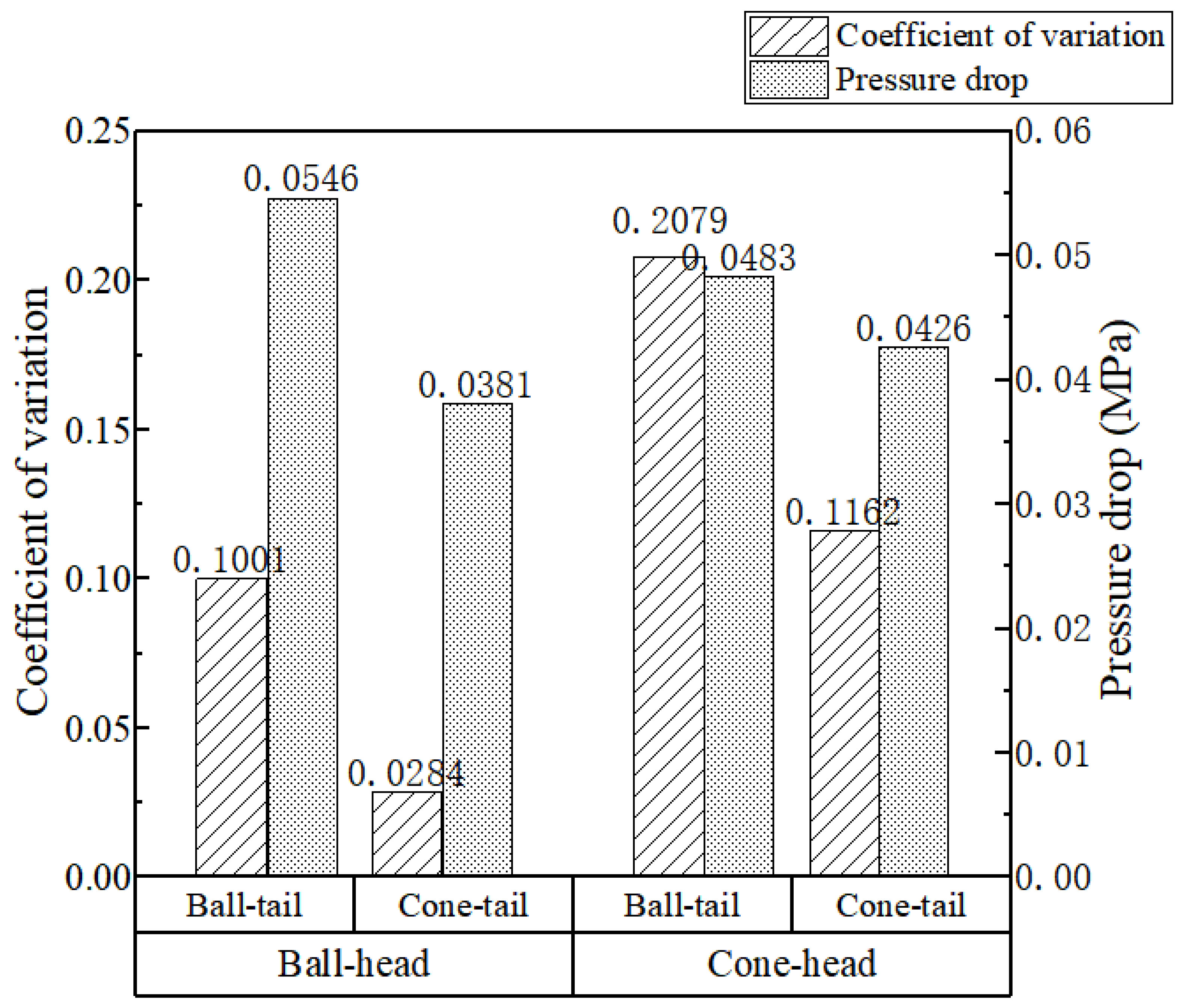
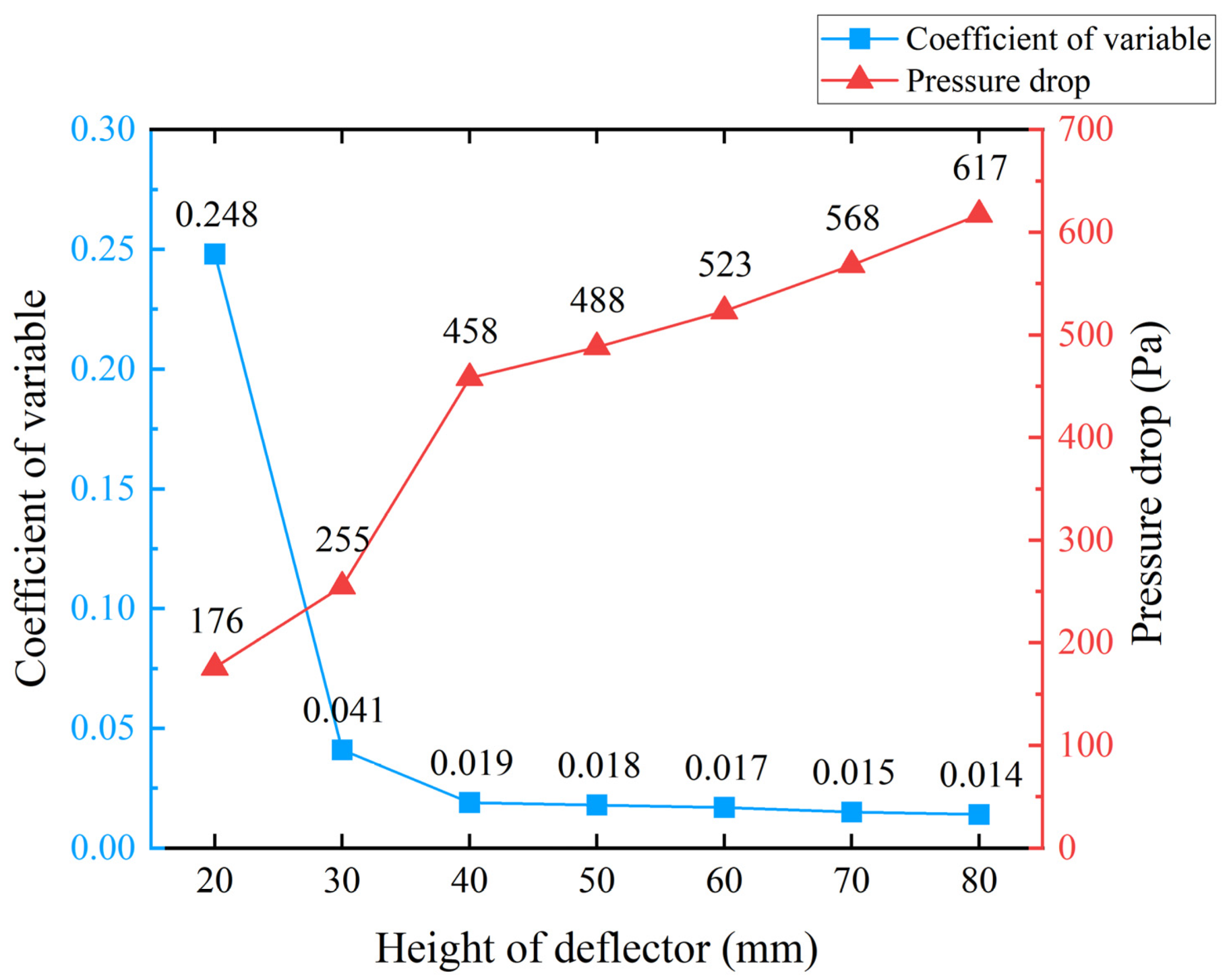

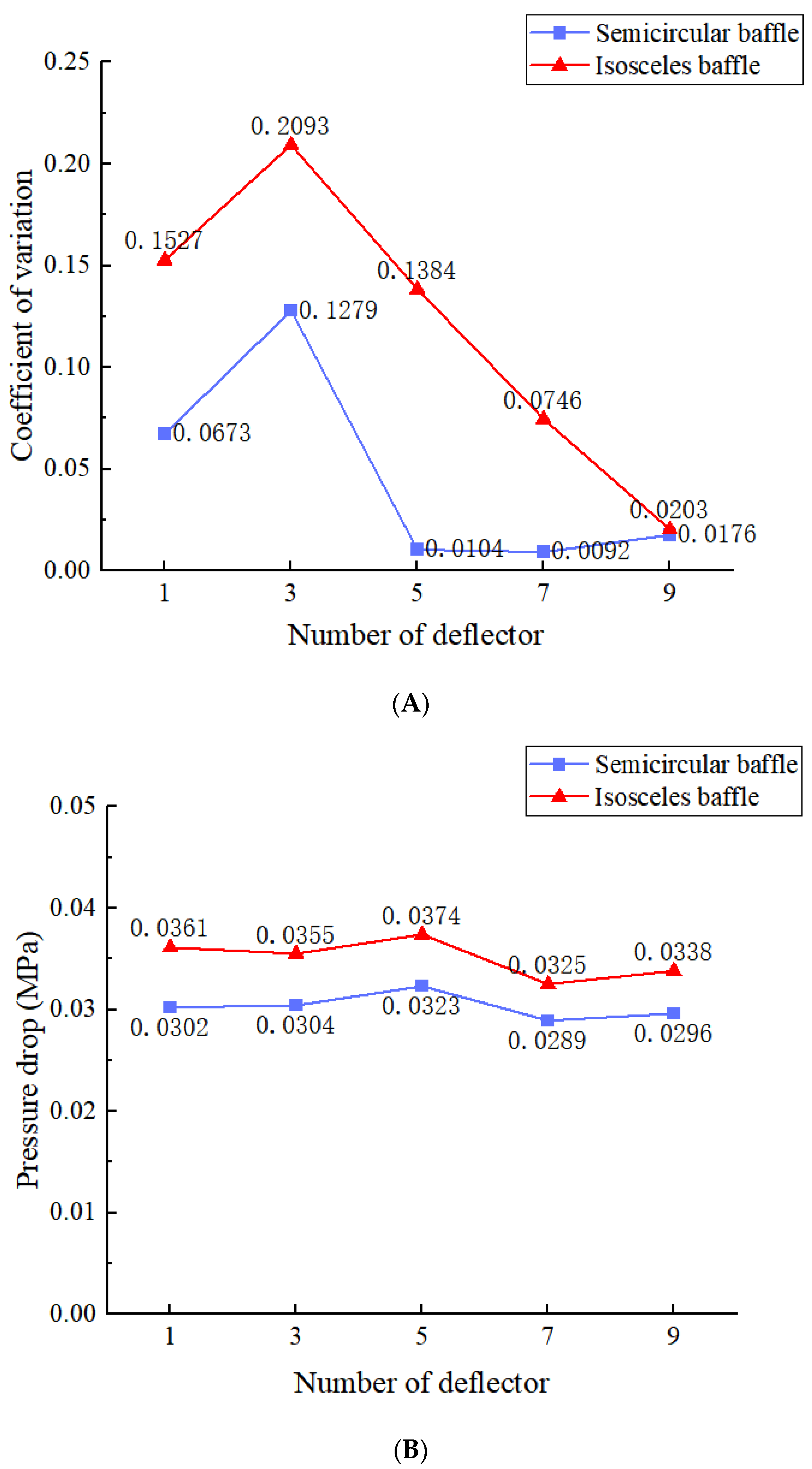
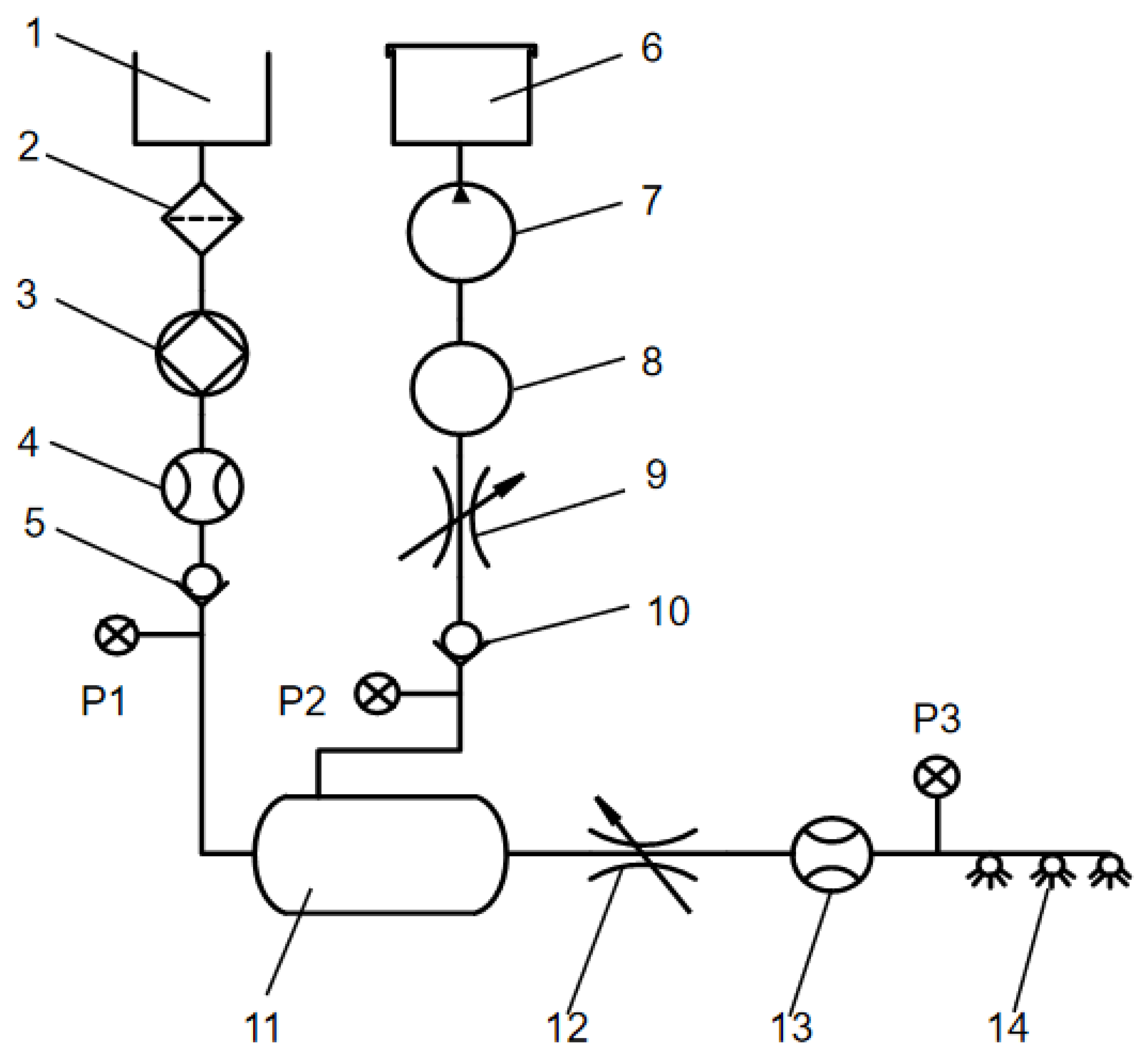


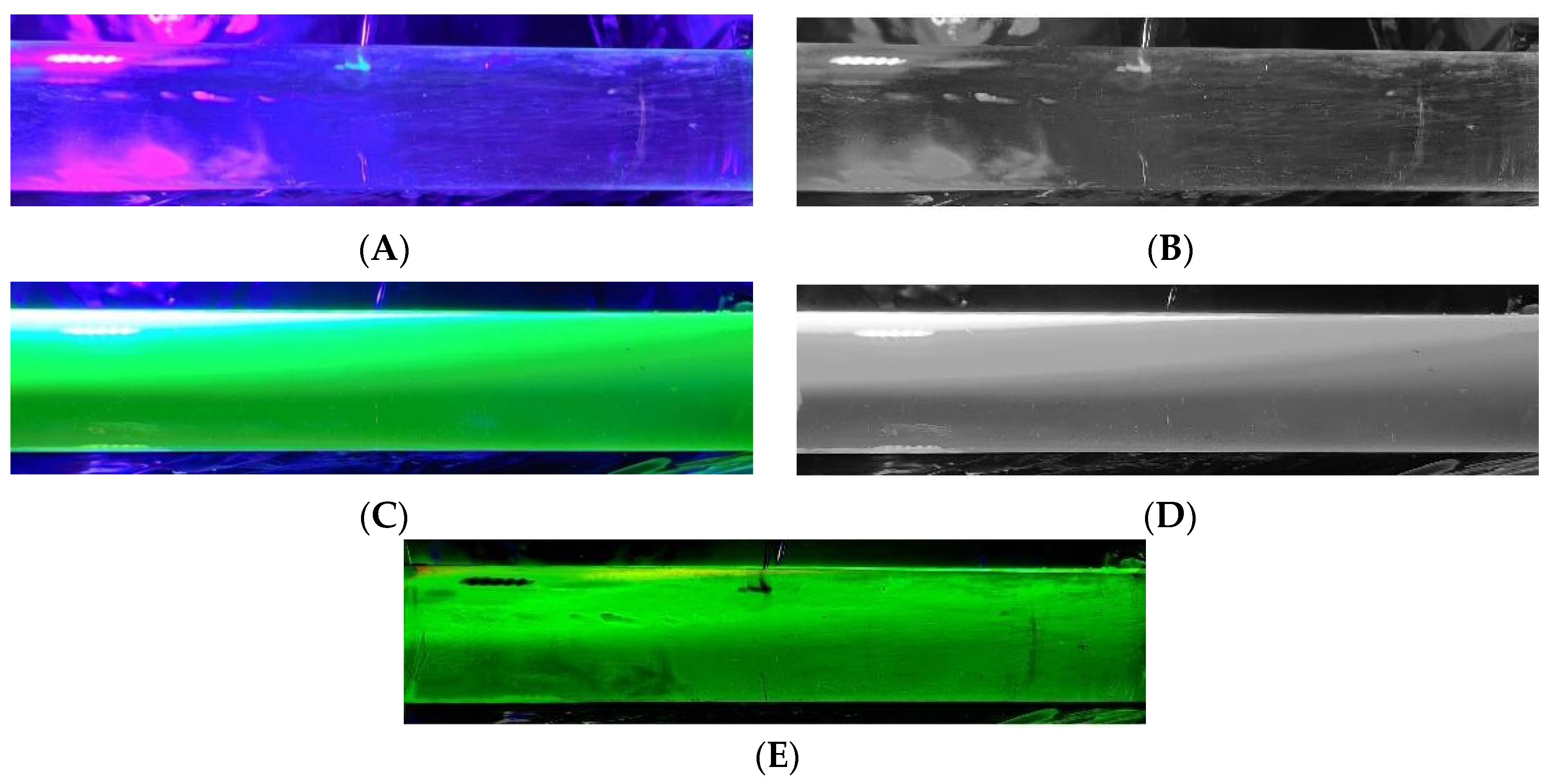

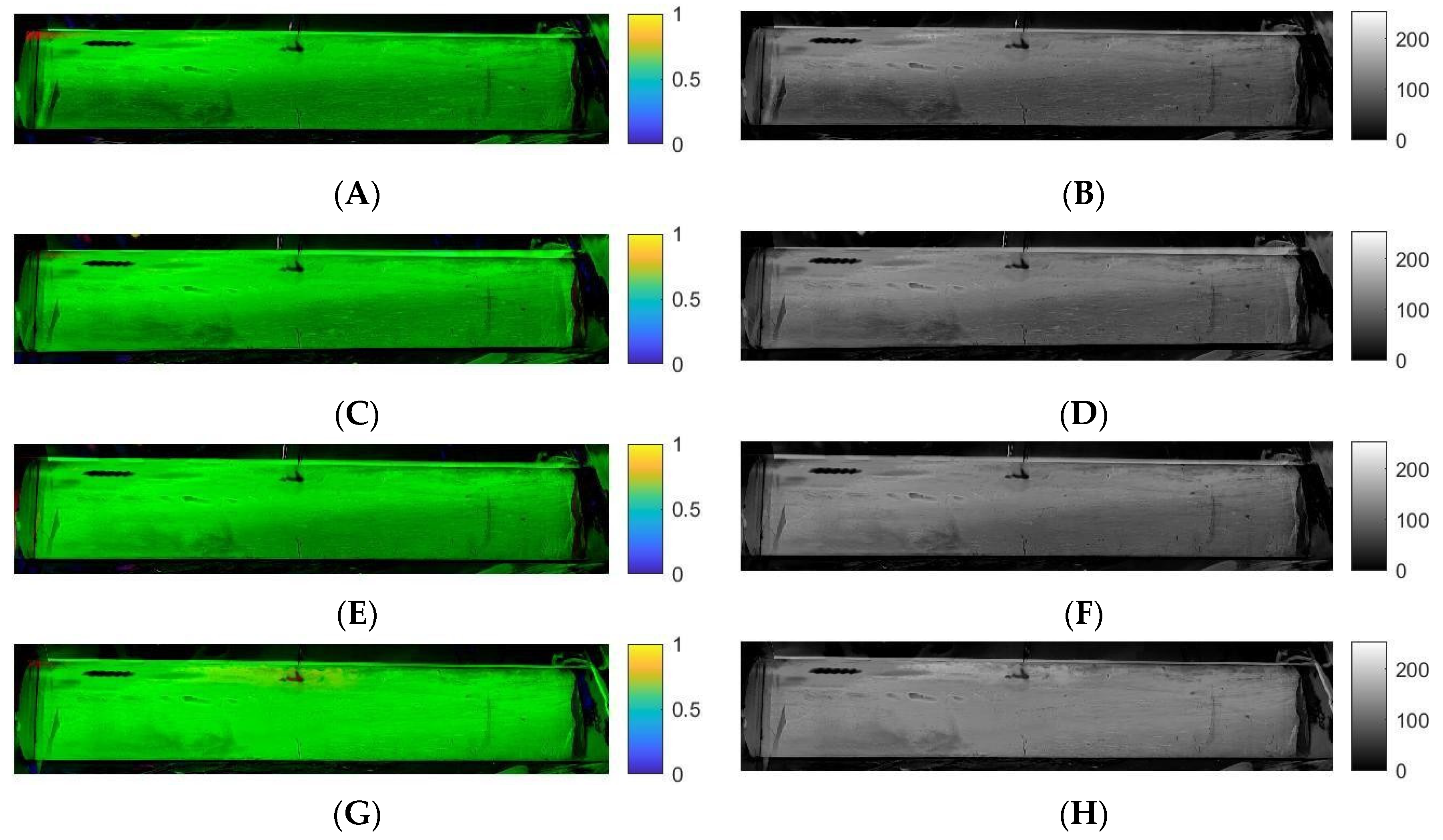


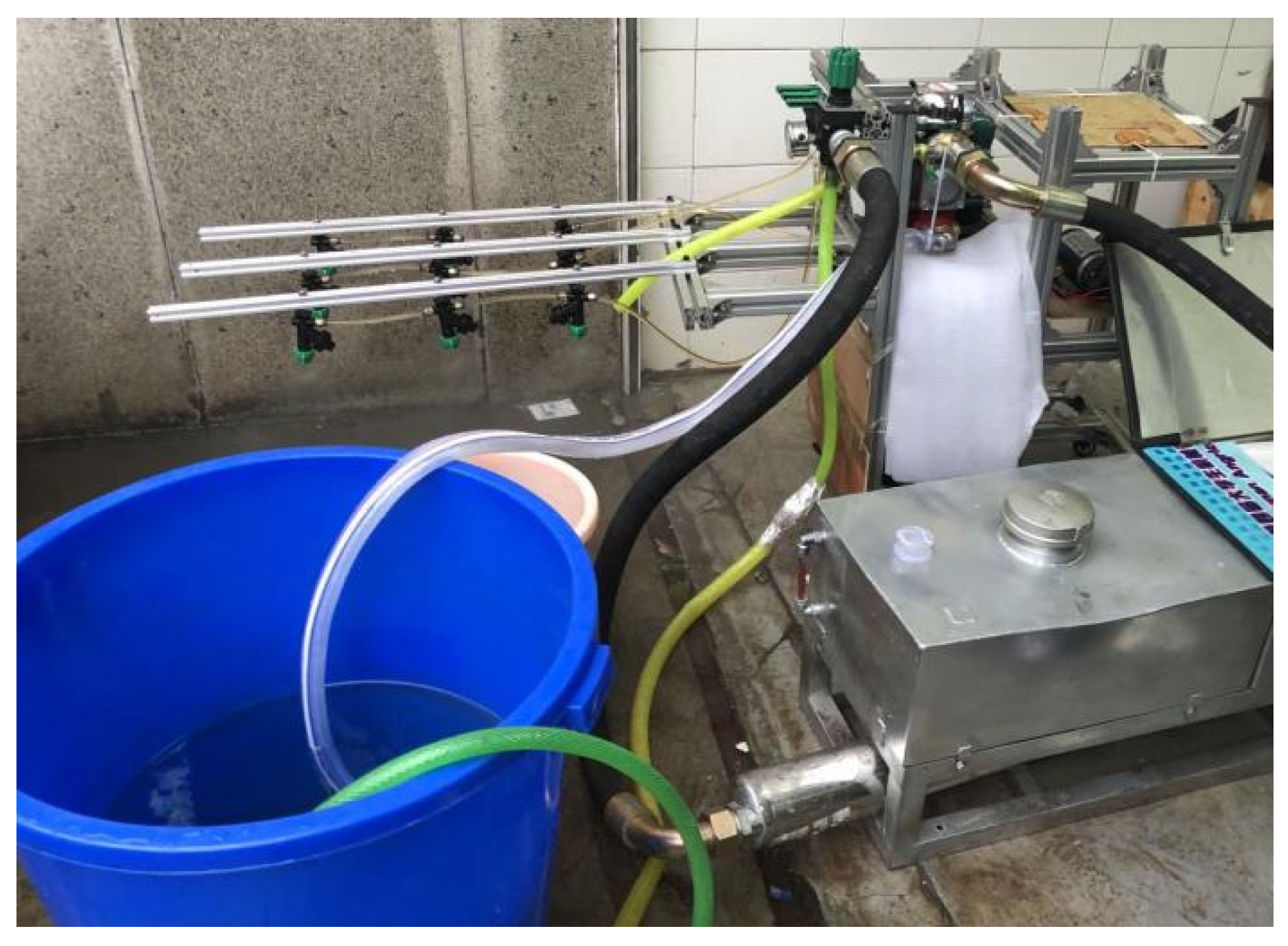
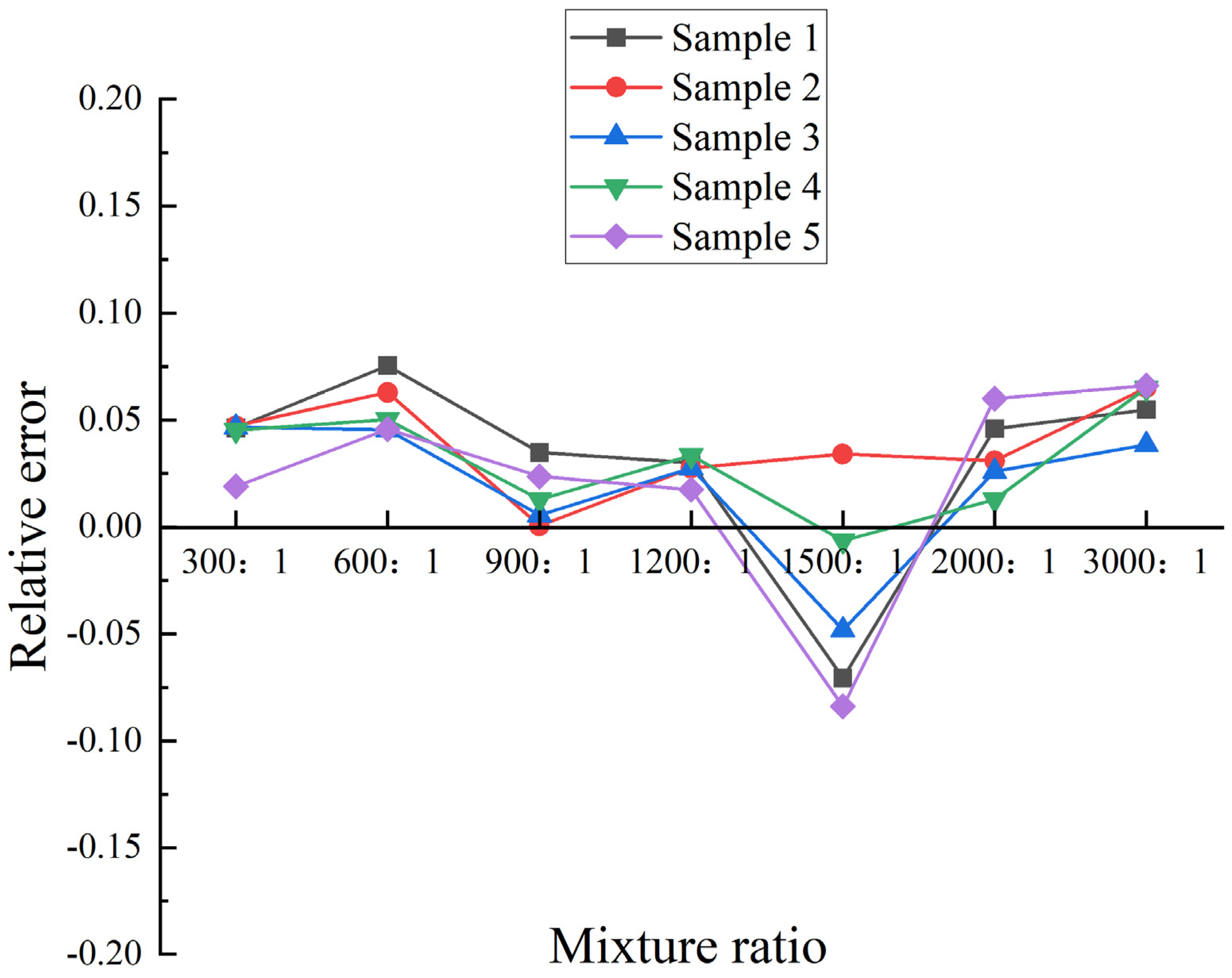

| Mixer Structure | Dimension Parameter (mm) |
|---|---|
| Cylindrical body length | 500 |
| Cylindrical body bore diameter | 100 |
| Head structure length | 65 |
| Water injection length | 60 |
| Water injection pipe diameter | 32 |
| Injection port length | 50 |
| Injection port diameter | 10 |
| Mixing outlet length | 60 |
| Mixed outlet pipe diameter | 32 |
| Water Injection Port | Pesticide Injection Port | |
|---|---|---|
| Hydraulic diameter (mm) | 32 | 10 |
| Water flow (L·min−1) | 140 | 0.466 |
| Density (kg·m−3) | 1000 | 1003 |
| Turbulence intensity (%) | 5 | 5 |
| Mixture Ratio | Coefficient of Variation of Each Axial Cross-Section Position of the Pesticide Mixer | ||||||
|---|---|---|---|---|---|---|---|
| 110 mm | 210 mm | 310 mm | 410 mm | 510 mm | 610 mm | 690 mm | |
| 300:1 | 26.11% | 11.24% | 5.58% | 4.01% | 3.15% | 3.11% | 2.22% |
| 600:1 | 26.74% | 11.28% | 5.24% | 3.51% | 2.91% | 2.90% | 2.88% |
| 900:1 | 26.85% | 11.37% | 5.05% | 3.28% | 2.88% | 2.84% | 2.63% |
| 1200:1 | 26.82% | 11.53% | 5.21% | 3.38% | 2.85% | 3.33% | 2.55% |
| 1500:1 | 27.39% | 11.43% | 5.01% | 3.29% | 2.77% | 3.35% | 2.34% |
| 2000:1 | 27.26% | 11.49% | 5.33% | 3.34% | 2.78% | 3.29% | 2.38% |
| 2500:1 | 25.44% | 10.70% | 5.27% | 4.01% | 2.83% | 3.12% | 2.54% |
| 3000:1 | 25.31% | 10.77% | 5.31% | 4.05% | 3.35% | 2.99% | 2.44% |
| Sample Number | Concentration (mg·L−1) | Absorbance |
|---|---|---|
| 1 | 1 | 0.022 |
| 2 | 1.5 | 0.033 |
| 3 | 2 | 0.041 |
| 4 | 2.5 | 0.053 |
| 5 | 3 | 0.066 |
| Mixture Ratio | Sample 1 | Sample 2 | Sample 3 | Sample 4 | Sample 5 | Expected Concentration |
|---|---|---|---|---|---|---|
| 300:1 | 9.557 | 9.549 | 9.555 | 9.568 | 9.814 | 10 |
| 600:1 | 4.649 | 4.704 | 4.783 | 4.761 | 4.781 | 5 |
| 900:1 | 3.218 | 3.328 | 3.311 | 3.288 | 3.253 | 3.33 |
| 1200:1 | 2.427 | 2.433 | 2.433 | 2.419 | 2.457 | 2.5 |
| 1500:1 | 2.152 | 1.934 | 2.101 | 2.013 | 2.183 | 2 |
| 2000:1 | 1.434 | 1.455 | 1.462 | 1.481 | 1.415 | 1.5 |
| 3000:1 | 0.948 | 0.939 | 0.963 | 0.939 | 0.938 | 1 |
| Sample Point | Sample Concentration at Various Mixing Ratios (mg·L−1) | ||||||
|---|---|---|---|---|---|---|---|
| 300:1 | 600:1 | 900:1 | 1200:1 | 1500:1 | 2000:1 | 3000:1 | |
| 1 | 9.541 | 4.681 | 3.094 | 2.388 | 1.912 | 1.417 | 0.918 |
| 2 | 9.544 | 4.683 | 3.095 | 2.389 | 1.914 | 1.418 | 0.920 |
| 3 | 9.543 | 4.682 | 3.094 | 2.388 | 1.913 | 1.417 | 0.919 |
| 4 | 9.544 | 4.683 | 3.095 | 2.389 | 1.914 | 1.418 | 0.918 |
| 5 | 9.544 | 4.683 | 3.095 | 2.389 | 1.914 | 1.418 | 0.920 |
| 6 | 9.543 | 4.682 | 3.094 | 2.388 | 1.913 | 1.417 | 0.919 |
| 7 | 9.543 | 4.682 | 3.094 | 2.388 | 1.913 | 1.417 | 0.919 |
| 8 | 9.543 | 4.682 | 3.094 | 2.388 | 1.913 | 1.417 | 0.919 |
| 9 | 9.544 | 4.683 | 3.095 | 2.389 | 1.914 | 1.418 | 0.918 |
| 10 | 9.544 | 4.683 | 3.095 | 2.389 | 1.914 | 1.418 | 0.918 |
Disclaimer/Publisher’s Note: The statements, opinions and data contained in all publications are solely those of the individual author(s) and contributor(s) and not of MDPI and/or the editor(s). MDPI and/or the editor(s) disclaim responsibility for any injury to people or property resulting from any ideas, methods, instructions or products referred to in the content. |
© 2023 by the authors. Licensee MDPI, Basel, Switzerland. This article is an open access article distributed under the terms and conditions of the Creative Commons Attribution (CC BY) license (https://creativecommons.org/licenses/by/4.0/).
Share and Cite
Shi, Y.; Xiang, S.; Xu, M.; Huang, D.; Liu, J.; Zhang, X.; Jiang, P. Design and Experimental Study of Ball-Head Cone-Tail Injection Mixer Based on Computational Fluid Dynamics. Agriculture 2023, 13, 1377. https://doi.org/10.3390/agriculture13071377
Shi Y, Xiang S, Xu M, Huang D, Liu J, Zhang X, Jiang P. Design and Experimental Study of Ball-Head Cone-Tail Injection Mixer Based on Computational Fluid Dynamics. Agriculture. 2023; 13(7):1377. https://doi.org/10.3390/agriculture13071377
Chicago/Turabian StyleShi, Yixin, Siliang Xiang, Minzi Xu, Defan Huang, Jianfei Liu, Xiaocong Zhang, and Ping Jiang. 2023. "Design and Experimental Study of Ball-Head Cone-Tail Injection Mixer Based on Computational Fluid Dynamics" Agriculture 13, no. 7: 1377. https://doi.org/10.3390/agriculture13071377




